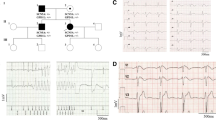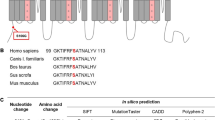Abstract
Diseases such as the sick sinus and the Brugada syndrome are cardiac abnormalities, which can be caused by a number of genetic aberrances. Among them are mutations in HCN4, a gene, which encodes the hyperpolarization-activated, cyclic nucleotide-gated ion channel 4; this pacemaker channel is responsible for the spontaneous activity of the sinoatrial node. The present genetic screening of patients with suspected or diagnosed Brugada or sick sinus syndrome identified in 1 out of 62 samples the novel mutation V492F. It is located in a highly conserved site of hyperpolarization-activated cyclic nucleotide-gated (HCN)4 channel downstream of the filter at the start of the last transmembrane domain S6. Functional expression of mutant channels in HEK293 cells uncovered a profoundly reduced channel function but no appreciable impact on channel synthesis and trafficking compared to the wild type. The inward rectifying HCN4 current could be partially rescued by an expression of heteromeric channels comprising wt and mutant monomers. These heteromeric channels were responsive to cAMP but they required a more negative voltage for activation and they exhibited a lower current density than the wt channel. This suggests a dominant negative effect of the mutation in patients, which carry this heterozygous mutation. Such a modulation of HCN4 activity could be the cause of the diagnosed cardiac abnormality.






Similar content being viewed by others
References
Anderson JB, Benson DW (2010) Genetics of sick sinus syndrome. Cardiac Electrophysiol Clinics 2:499–507
Antzelevitch C (2005) Brugada syndrome: report of the second consensus conference: endorsed by the Heart Rhythm Society and the European heart rhythm association. Circulation 111:659–670
Altomare C, Terragni B, Brioschi C, Milanesi R, Pagliuca C, Viscomi C, Moroni A, DiFrancesco D (2003) Heteromeric HCN1-HCN4 channels: a comparison with native pacemaker channels from the rabbit sinoatrial node. J Physiol 549:347–359
Arbelo E, Brugada J (2014) Risk stratification and treatment of Brugada syndrome. Curr Cardiol Rep 16:508. doi:10.1007/s11886-014-0508-1
Baruscotti M, Bucchi A, Viscomi C, Mandelli G, Consalez G, Gnecchi-Rusconi T, Montano N, Rabello Casali K, Micheloni S, Barbuti A, DiFrancesco D (2011) Deep bradycardia and heart block caused by inducible cardiac-specific knockout of the pacemaker channel gene Hcn4. Proc Natl Acad Sci U S A 108:1705–1710
Baruscotti M, Bucchi A, Milanesi R, Paina M, Barbuti A, Gnecchi-Ruscone T, Bianco E, Vitali-Serdoz L, Cappato R, DiFrancesco D (2016) A gain-of-function mutation in the cardiac pacemaker HCN4 channel increasing cAMP sensitivity is associated with familial inappropriate sinus tachycardia. Eur Heart J . doi:10.1093/eurheartj/ehv582in press
Bezrukov L, Blank PS, Polozov IV, Zimmerberg J (2009) An adhesion-based method for plasma membrane isolation: evaluating cholesterol extraction from cells and their membranes. Anal Biochem 394:171–176
Biel M, Wahl-Schott C, Michalakis S, Zong X (2009) Hyperpolarization-activated cation channels: from genes to function. Physiol Rev 89:847–885
Brugada R, Brugada R, Campuzano O, Sarquella-Brugada G, Brugada J, Brugada P (2014) Brugada syndrome. Methodist Debakey Cardiovas J 10:25–28
Chandler NJ, Greener ID, Tellez JO, Inada S, Musa H, Molenaar P, DiFrancesco D, Baruscotti M, Longhi R, Anderson RH, Billeter R, Sharma V, Sigg DC, Boyett MR, Dobrzynski H (2009) Molecular architecture of the human sinus node: insights into the function of the cardiac pacemaker. Circulation 119:1562–1575
DiFrancesco D, Tortora P (1991) Direct activation of cadiac pacemaker channels by intracellular cyclic AMP. Nature 351:145–147
DiFrancesco D (1999) Dual allosteric modulation of pacemaker (f) channels by cAMP and voltage in rabbit SA node. J Physiol 515:367–376
DiFrancesco D (2010) The role of the funny current in pacemaker activity. Circ Res 106:434–446
DiFrancesco D (2013) Funny channel gene mutations associated with arrhythmias. J Physiol 591:4117–4124
DiFrancesco D (2015) HCN4, sinus bradycardia and atrial fibrillation. Arrhythm Electrophysiol Rev 4:9–13
Duhme N, Schweizer PA, Thomas D, Becker R, Schröter J, Barends TR, Schlichting I, Draguhn A, Bruehl C, Katus HA, Koenen M (2013) Altered HCN4 channel C-linker interaction is associated with familial tachycardia-bradycardia syndrome and atrial fibrillation. Eur Heart J 34:2768–2775
Ewy GA (2014) Sick Sinus Syndrome. J Am Coll Cardiol 64:539–540
Gregoratos G (2003) Sick sinus syndrome. Circulation 108:143–144
Guthmann T (2013) The outer transmembrane domain of the Kesv channel determines its intracellular localization: A molecular and microscopic analysis of protein sorting. PhD Thesis TU Darmstadt. http://tuprints.ulb.tu-darmstadt.de/id/eprint/3520
Keller KB, Lemberg L (2006) The sick sinus syndrome. Am J Crit Care 15:226–229
Laish-Farkash A, Glikson M, Brass D, Marek-Yagel D, Pras E, Dascal N, Antzelevitch C, Nof E, Reznik H, Eldar M, Luria D (2010) A novel mutation in the HCN4 gene causes symptomatic sinus bradycardia in moroccan jews. J Cardiovas Electrophysiol 21:1365–1372
Lolicato M, Bucchi A, Arrigoni C, Zucca S, Nardini M, Schroeder I, Simmons K, Aquila M, DiFrancesco D, Bolognesi M, Schwede F, Kashin D, Fishwick CW, Johnson AP, Thiel G, Moroni A (2014) Cyclic dinucleotides bind the C-linker of HCN4 to control channel cAMP responsiveness. Nat Chem Biol 10:457–462
Macri V, Mahida SN, Zhang ML, Sinner MF, Dolmatova EV, Tucker NR, McLellan M, Shea MA, Milan DJ, Lunetta KL, Benjamin EJ, Ellinor PT (2014) A novel trafficking- defective HCN4 mutation is associated with early-onset atrial fibrillation. Heart Rhythm 11:1055–1062
Milanesi R, Baruscotti M, Gnecchi-Ruscone T, DiFrancesco D (2006) Familial sinus bradycardia associated with a mutation in the cardiac pacemaker channel. N Engl J Med 354:151–157
Milano A, Vermeer AM, Lodder EM, Barc J, Verkerk AO, Postma AV, van der Bilt IA, Baars MJ, van Haelst PL, Caliskan K, Hoedemaekers YM, Le Scouarnec S, Redon R, Pinto YM, Christiaans I, Wilde AA, Bezzina CR (2014) HCN4 mutations in multiple families with bradycardia and left ventricular noncompaction cardiomyopathy. J Am Col Cardiol 64:745–756
Nawathe PA, Kryukova Y, Oren RV, Milanesi R, Clany CE, Lu JT, Moss AJ, DiFranceso D, Robinson RB (2013) An LQTS6 MiRP1 mutation suppresses pacemaker current and is associated with sinus bradycardia. J Cardivasc Electrophysil 24:1021–1027
Nof E, Luria D, Brass D, Marek D, Lahat H, Reznik-Wolf H, Pras E, Dascal N, Eldar M, Glikson M (2007) Point mutation in the HCN4 cardiac ion channel pore affecting synthesis, trafficking, and functional expression is associated with familial asymptomatic sinus bradycardia. Circulation 116:463–470
Semelka M, Gera J, Usman S (2003) Sick sinus syndrome: a review. Am Fam Physician 87:691–696
Schulze-Bahr E, Neu A, Friederich P, Kaupp UB, Breithardt G, Pongs O, Isbrandt O (2003) Pacemaker channel dysfunction in a patient with sinus node disease. J Clin Invest 111:1537–1545
Schweizer PA, Duhme N, Thomas D, Becker R, Zehlein J, Draguhn A, Bruehl C, Katus HA, Koenen M (2010) cAMP sensitivity of HCN pacemaker channels determines basal heart rate but is not critical for autonomic rate control. Circ Arrhithm Electrophysiol 3:542–552
Schweizer PA, Schröter J, Greiner S, Haas J, Yampolsky P, Mereles D, Buss SJ, Seyler C, Bruehl C, Draguhn A, Koenen M, Meder B, Katus HA, Thomas D (2014) The symptom complex of familial sinus node dysfunction and myocardial noncompaction is associated with mutations in the HCN4 channel. J Am Col Cardiol 64:757–767
Ueda K, Nakamura K, Hayashi T, Inagaki N, Takahashi M, Arimura T, Morita H, Higashiuesato Y, Hirano Y, Yasunami M, Takishita S, Yamashina A, Ohe T, Sunamori M, Hiraoka M, Kimura A (2004) Functional characterization of a trafficking-defective HCN4 mutation, D553N, associated with cardiac arrhythmia. J Biol Chem 279:27194–27198
Ueda K, Hirano Y, Higashiuesato Y, Aizawa Y, Hayashi T, Inagaki N, Tana T, Ohya Y, Takishita S, Muratani H, Hiraoka M, Kimura A (2009) Role of HCN4 channel in preventing ventricular arrhythmia. J Hum Genet 54:115–121
Ulens C, Siegelbaum SA (2003) Regulation of hyperpolarization-activated HCN channels by cAMP through a gating switch in binding domain symmetry. Neuron 40:959–970
Wahl-Schott C, Biel M (2009) HCN channels: structure, cellular regulation and physiological function. Cell Mol Life Sci 66:470–494
Wilde AA (2002) Proposed diagnostic criteria for the Brugada syndrome: consensus report. Circulation 106:2514–2519
Zhou J, Ding WG, Makiyama T, Miyamoto A, Matsumoto Y, Kimura H, Tarutani Y, Zhao J, Wu J, Zang WJ, Matsuura H, Horie M (2014) A novel HCN4 mutation, G1097 W, is associated with atrioventricular block. Circ J 78:938–942
Acknowledgments
This work was supported by grant no. PGR00139 from MAECI (Ministero affari esteri e cooperazione internazionale), CARIPLO grants 2014-0660 to AM and grant 2014-0728 to DD.
Author information
Authors and Affiliations
Corresponding author
Additional information
Stephanie Biel and Marco Aquila contributed equally to this work.
Rights and permissions
About this article
Cite this article
Biel, S., Aquila, M., Hertel, B. et al. Mutation in S6 domain of HCN4 channel in patient with suspected Brugada syndrome modifies channel function. Pflugers Arch - Eur J Physiol 468, 1663–1671 (2016). https://doi.org/10.1007/s00424-016-1870-1
Received:
Revised:
Accepted:
Published:
Issue Date:
DOI: https://doi.org/10.1007/s00424-016-1870-1




